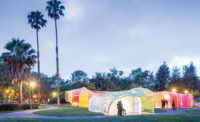 |
| Image courtesy |
The Solomon R. Guggenheim Museum and BMW announced on Friday that they will collaborate for the next six years on a project called the BMW Guggenheim Lab, an initiative to conduct a vast research and development project that will engage the public and improve urban life. Details about the format of the Lab project and the expected results were slim. “The goal is to develop and create solutions for future cities,” said Frank-Peter Arndt, a member of the board of management from BMW Group, at a press conference held in the basement of the Guggenheim.
While the project’s ambiguities seemed to vex a couple of audience members, the basic idea is this: Led by two curators from the Guggenheim, the first Lab will likely include a café, a workspace, and an area for free public programming. Housed in a moveable structure designed by Atelier Bow-Wow, a Tokyo-based architecture firm that has designed mobile and prefabricated projects for urban settings, the Lab will open in a yet unnamed North American city in late summer 2011. An advisory team of nine experts from various disciplines will nominate Lab team candidates. Ultimately, four candidates will be chosen, also from mixed disciplines such as art, architecture, science, and economics. They will work in the Lab to address a chosen theme, the first of which is “Confronting Comfort: The City and You.” The Lab will pack up and move to two other cities – in Asia and Europe – for a total two-year cycle.
 |
| Image courtesy |
That cycle will repeat twice more, with a new architect and new theme each cycle, for a total of nine cities visited over the course of six years. At the end of every two years, the Guggenheim will host an exhibit of the data and visuals that result from the previous Lab.
Maria Nicanor, an assistant curator at the Guggenheim, called the initiative a mash-up of a think tank, community center, and gallery space. “We tend to have a lack of ownership about the city, that we can’t change them,” she said. The idea behind the Lab is to reverse that thinking. Thomas Girst, a BMW spokesman, called the project a “beehive,” not a “UFO.”
In regards to the first selected theme, a member of Friday’s audience asked about sensitivity around the word “comfort,” especially during a time of high unemployment in the U.S. One person’s idea of comfort may be entirely different from another’s, the guest said. “It’s a taboo word in society, especially in the U.S.,” said David van der Leer, assistant curator of architecture and design at the museum and Nicanor’s curatorial partner in the Lab project. He assumes and hopes that the different locations of the Lab, and varying public input, will produce completely different solutions for discomforts associated with city living, he said.
The designs for the first Lab, its location, and the Lab team members will be announced this spring, said Nicanor. Guggenheim Museum and Foundation Director Richard Armstrong declined to reveal the budget for the collaboration, but said, “It’s robust.”





Post a comment to this article
Report Abusive Comment